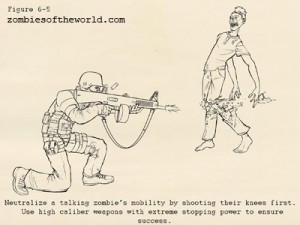Zombies of the World first began with a single observation about zombies – they never get tired. To me, that seemed more interesting than their resurrection or predilection for human flesh. Even the few zombies that manage to catch and eat a human never seem to digest the meat and true zombies never starve. They continue to burn energy without taking in fuel. This defies the laws of thermodynamics and makes the zombie a flesh eating perpetual motion machine. With that, I began to think of how that would affect the world so I could tell my own zombie story. The genre is dominated by survivalist themed works that can be fun or even great but I wanted to do something different with them.
While zombie apocalypses are fun for storytelling and gaming purposes, they tend to follow several rules:
- Zombie populations go from 0 to infinity within hours or days. Even if they are slow, shambling zombies, civilization breaks down very quickly after the initial outbreak because there are too many zombies to count.
- Survivors of an apocalypse do not act like survivors from any other type of major disaster. For example, after the recent earthquake in Japan, even the Yakuza helped their fellow citizens out. This would never happen in a zombie apocalypse apparently though. Survivors do not cooperate, help one another or usually even act with a modicum of rationality.
- Zombies have no ancestors or history – they spawn once and wipe out civilization.
- There is little or no speciation in zombies. All zombies worldwide are of one type. There might be a few differing types, especially in video game based zombie apocalypses (Left 4 Dead and Resident Evil come to mind).
With that in mind, I wanted to break these rules so I could see how a stable society would treat the undead. So you would get:
- Zombie populations grow slowly and migration takes time. There are limited numbers of them, so it is possible to contain the undead.
- People cooperate during a zombie attack, putting aside their differences and acting rationally. They learn from their mistakes and work together to fight the undead and protect each other.
- Zombies have been present throughout history so humanity has learned how to fight them.
- The undead evolved over time and there are multitudes of species throughout the world. Varying environmental conditions favored different traits.
There have been a few stories set in worlds where humanity and zombies have learned to co-exist but they tend to be post-apocalyptic – societies that rebuild after the zombies nearly wipe everything out. By breaking all of these rules, you get a world that has had to deal with the undead for thousands of years but has learned how to deal with them.
Furthermore, wouldn’t the scientists of that world study them and try to learn how they remain animate after death? So, I pictured a world much like our own. Zombies were contained by government agencies. Some species were endangered or even extinct. Scientists and environmentalists lobbied for laws to protect the undead, because they were part of the ecosystem and needed to be studied. That is how Zombies of the World began.

